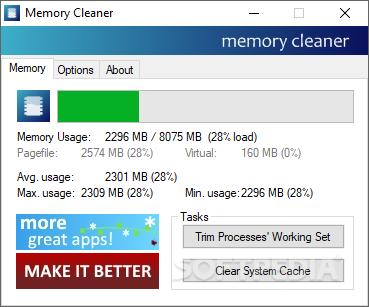

- #MINECRAFT MEMORY CLEANER 1.8 UPDATE#
- #MINECRAFT MEMORY CLEANER 1.8 MANUAL#
- #MINECRAFT MEMORY CLEANER 1.8 CODE#
- #MINECRAFT MEMORY CLEANER 1.8 FREE#
If you see that your memory increases in the 'Monitor' tab, try pressing 'Perform GC' (garbage collection) and see if that decreases memory usage. Inspect the ' Monitor' and the 'memory pools' tab.Perform the operation that causes the sluggish performance.
#MINECRAFT MEMORY CLEANER 1.8 FREE#
Select these plugins (feel free to browse and add more if you like): Go to Tools -> Plugins -> 'Available Plugins'. Before VisualVM became useful to me, I first had to add some plugins. Launch VisualVM, then try your luck again.
#MINECRAFT MEMORY CLEANER 1.8 UPDATE#
#MINECRAFT MEMORY CLEANER 1.8 CODE#
You could read all of your code and try to understand where the leak occurs.
#MINECRAFT MEMORY CLEANER 1.8 MANUAL#
If you got this far then you'll have to roll up your selves and do some manual labor. 2) Manually disable & enable parts of your code and observe memory usage of your JVM using a JVM tool like VisualVM.

If you're in this place, you may want to try step 2. Or sometimes file opening/closures are nested so deeply that eclipse won't detect them. Especially when working with legacy (pre 1.5) code, you'll likely run into leaks because those were written before 'closable' was implemented. However, even with fancy Eclipse hocus pocus, not all file closures and leaks are detected. Go to your project settings and enable them as demonstrated: However, the leak-detection isn't always enabled in eclipse projects. To be more precise, anything that implements closable (since 1.5) (e.g outputstream since 1.5) will throw a warning at you if its reference is destroyed but the object is not closed. 2) Manually disable & enable parts of your code and observe memory usage of your JVM using a JVM tool like VisualVM (or Jconsole, or Thermostat).ġ) Quick fix: Eclipse Memory Leak warning/errors.įor code with JDK 1.5+ compliance, eclipse will throw warnings and errors at you for obvious cases of leaks.1) Quick fix: Eclipse Memory Leak Warnings (catches some leaks).If that fails then you'll have to go down the long road. Inner classes that reference outer classes can leak.Map.put(new MemLeak(" key" ), " value" ) Hash maps keeping references alive if equals() and hashcode() are not implemented, e.g.Ever increasing Old-Generation memory usage in your JVMĪ memory leak in Java (who would've thought heh?) can occur if you forget to close a resource, or a reference to an object is not released.Works fine with small data sets, severe performance issues with large data sets.Works fast at first, but slows over time. While in general the approach described in this article is IDE & OS independent, I used Linux and Eclipse in the screenshots & instructions. When fixing memory leaks If someone were to ask me: "If you knew back then what you know now, what would you tell yourself?". Do you have a Java application that runs fine at first but slows down after a while, or it runs fine for a small number of files but performance degrades for large number of files? Maybe you have a memory leak.


 0 kommentar(er)
0 kommentar(er)
